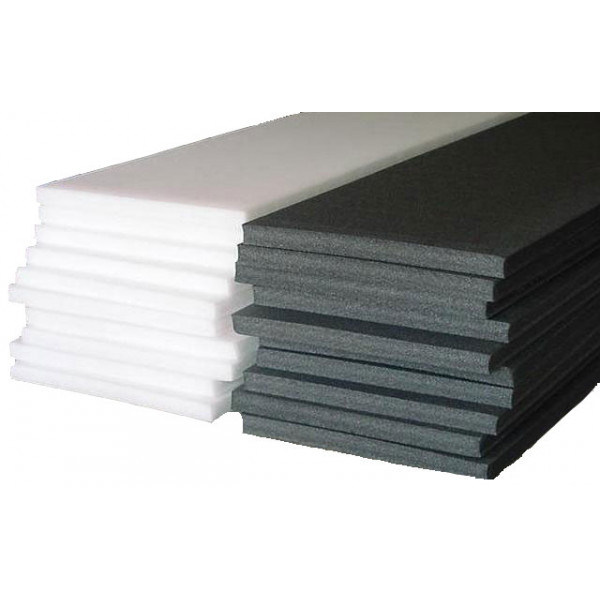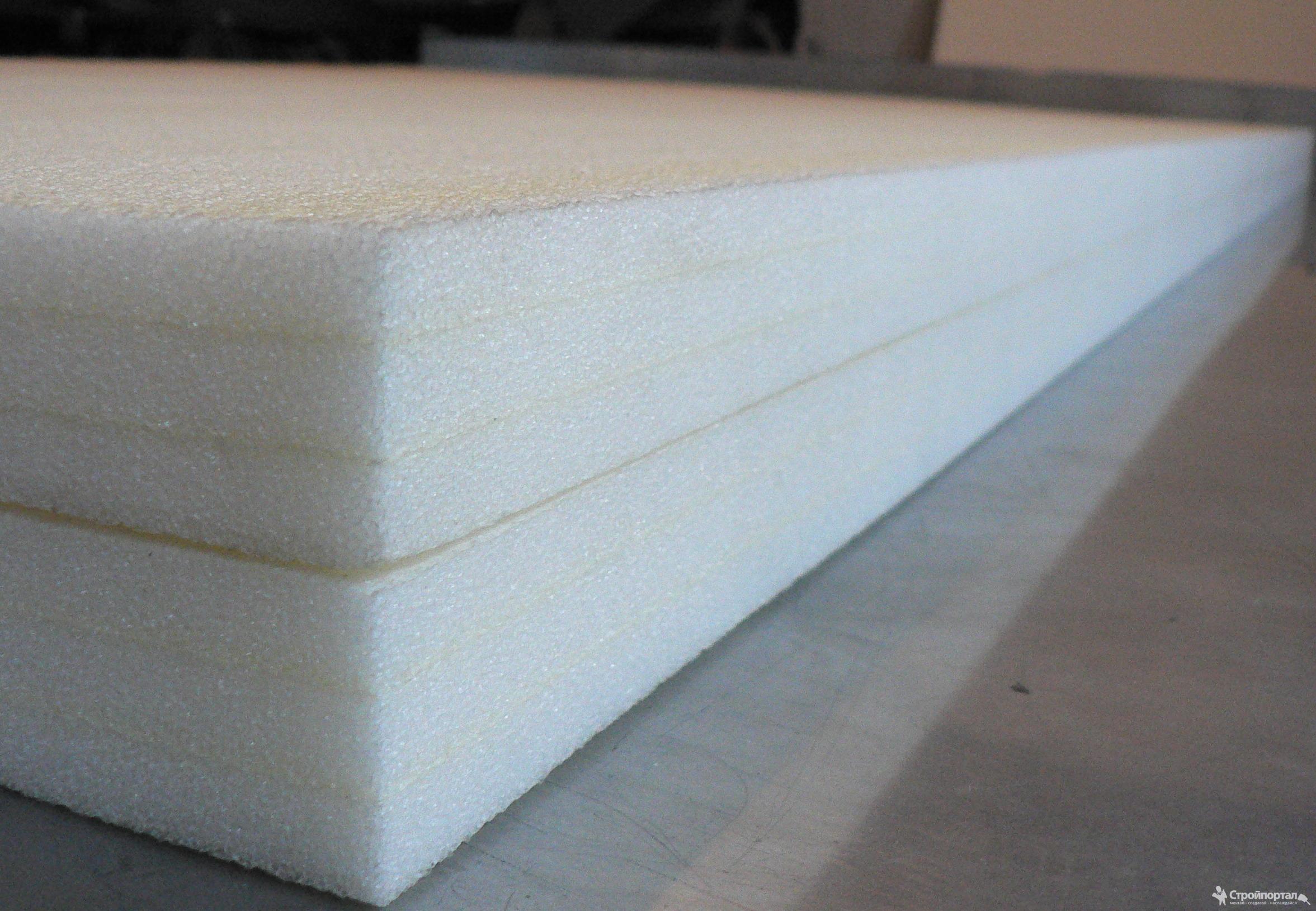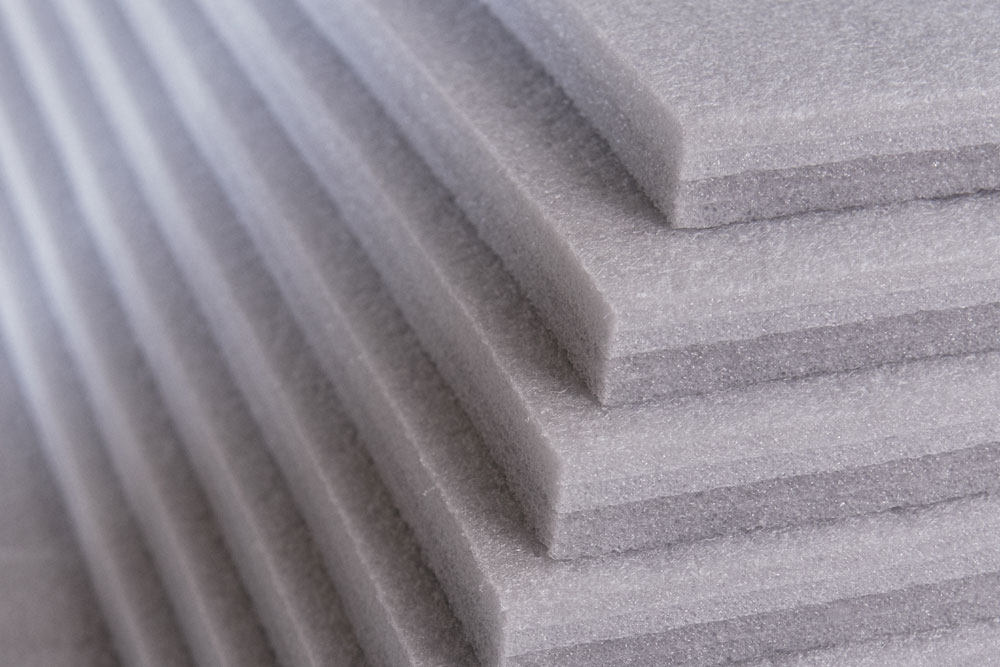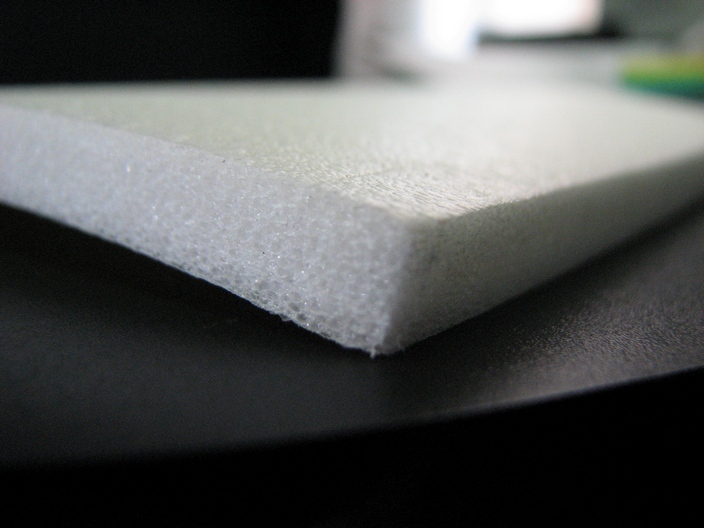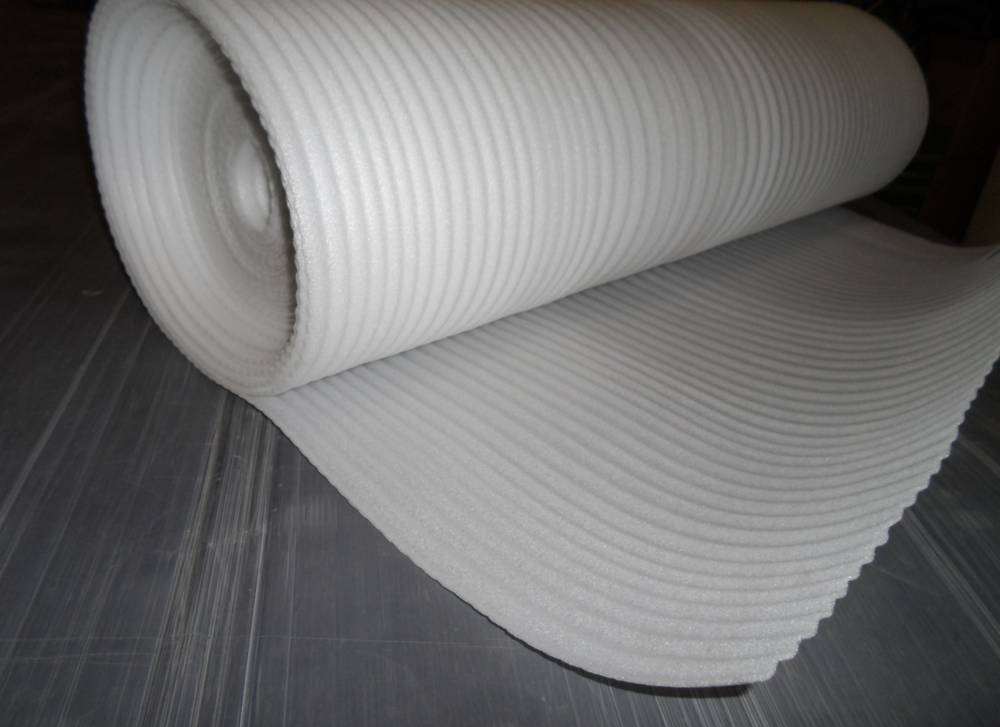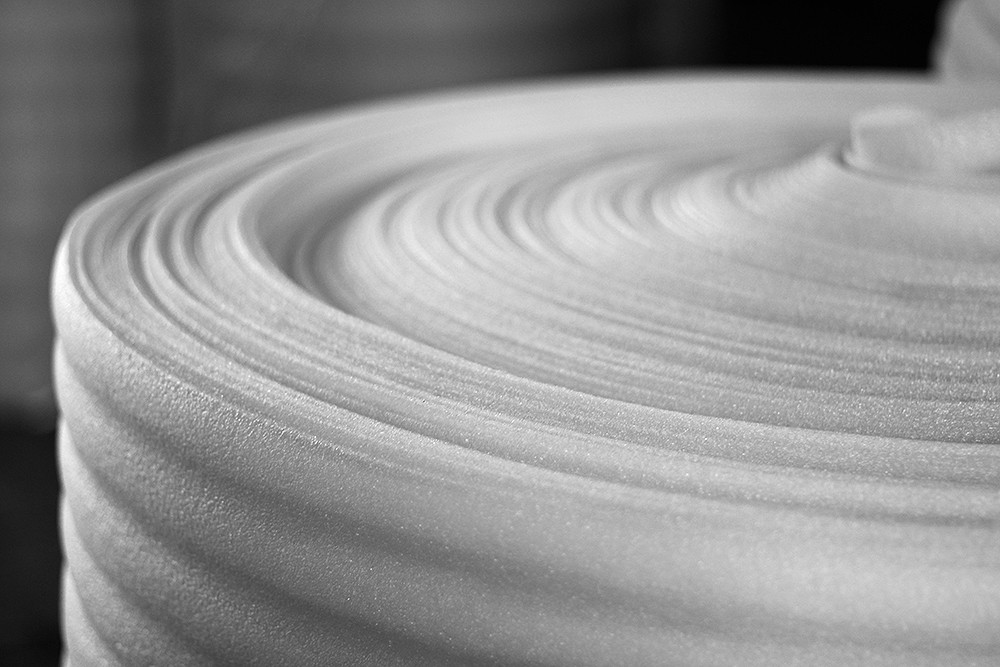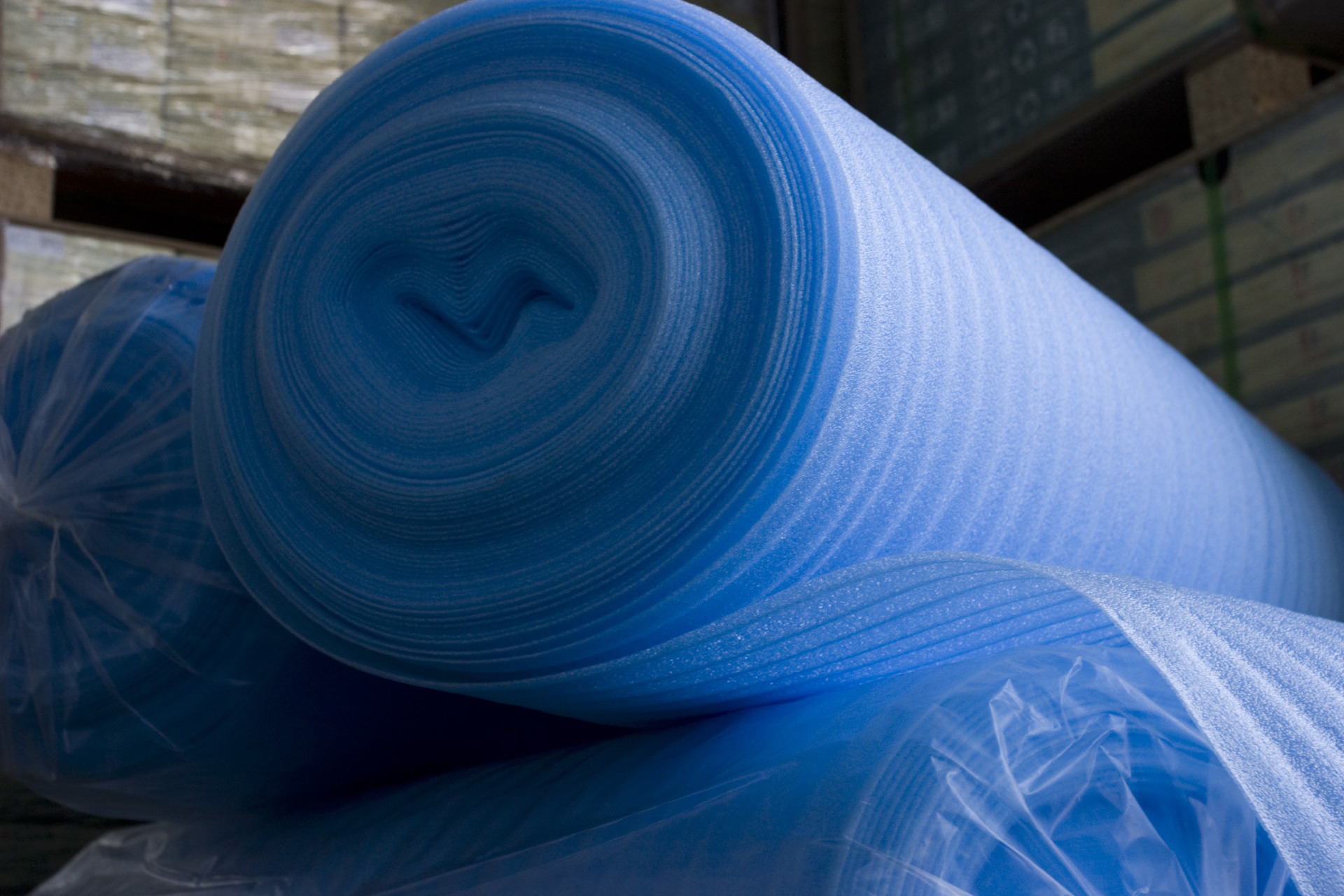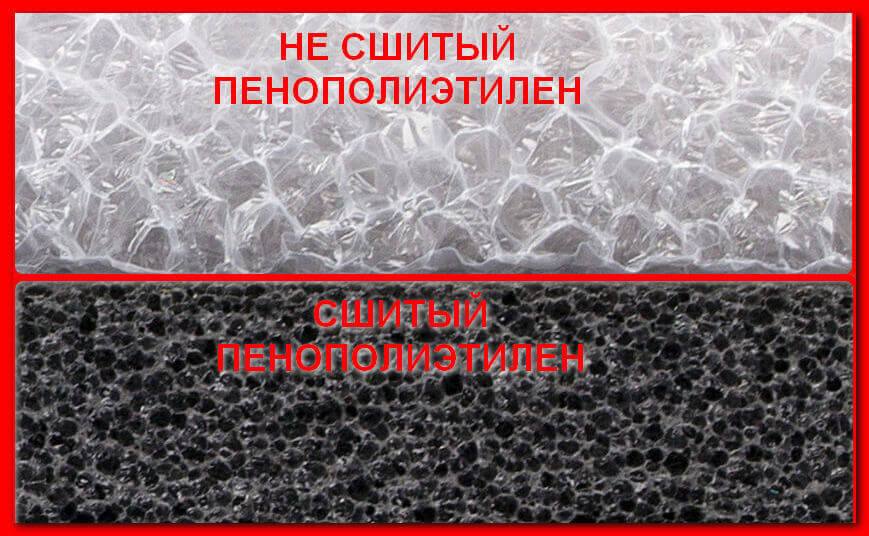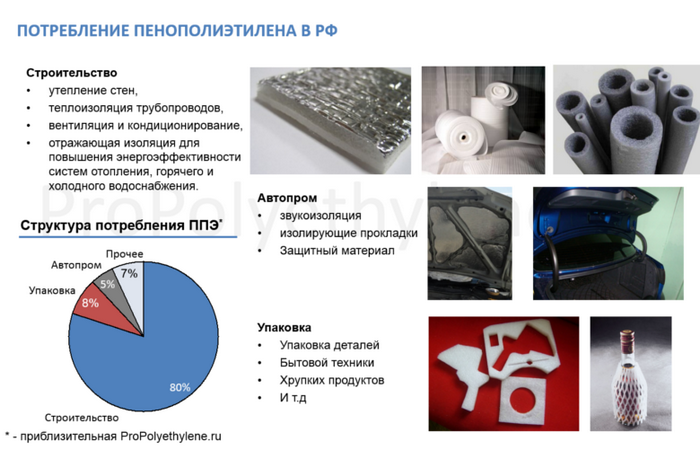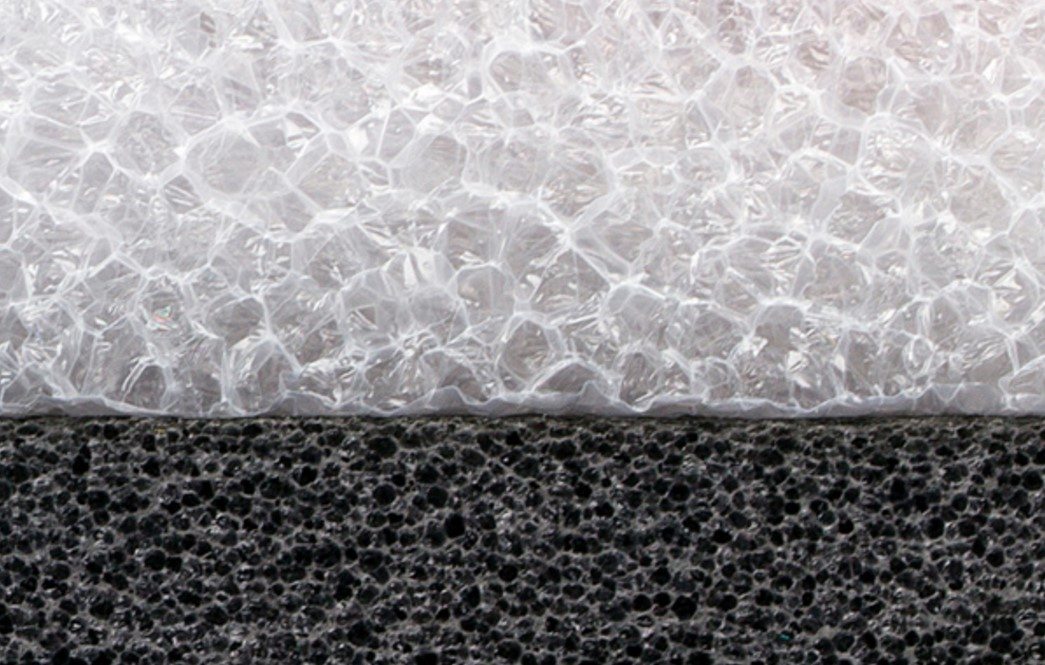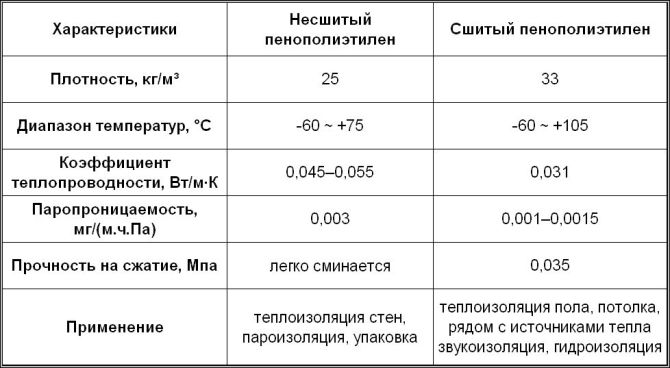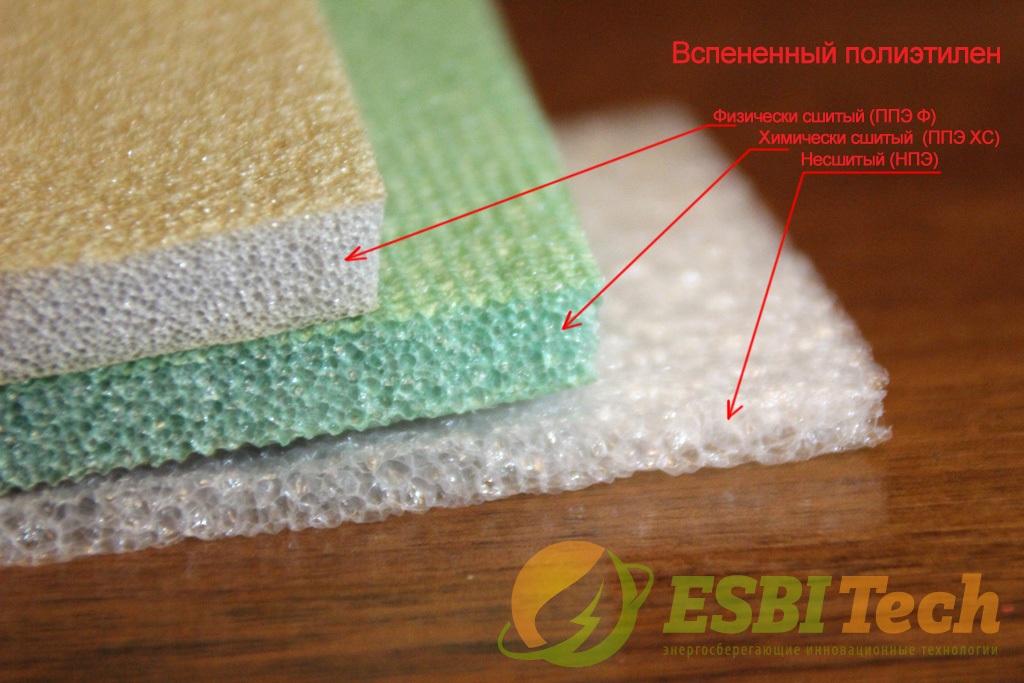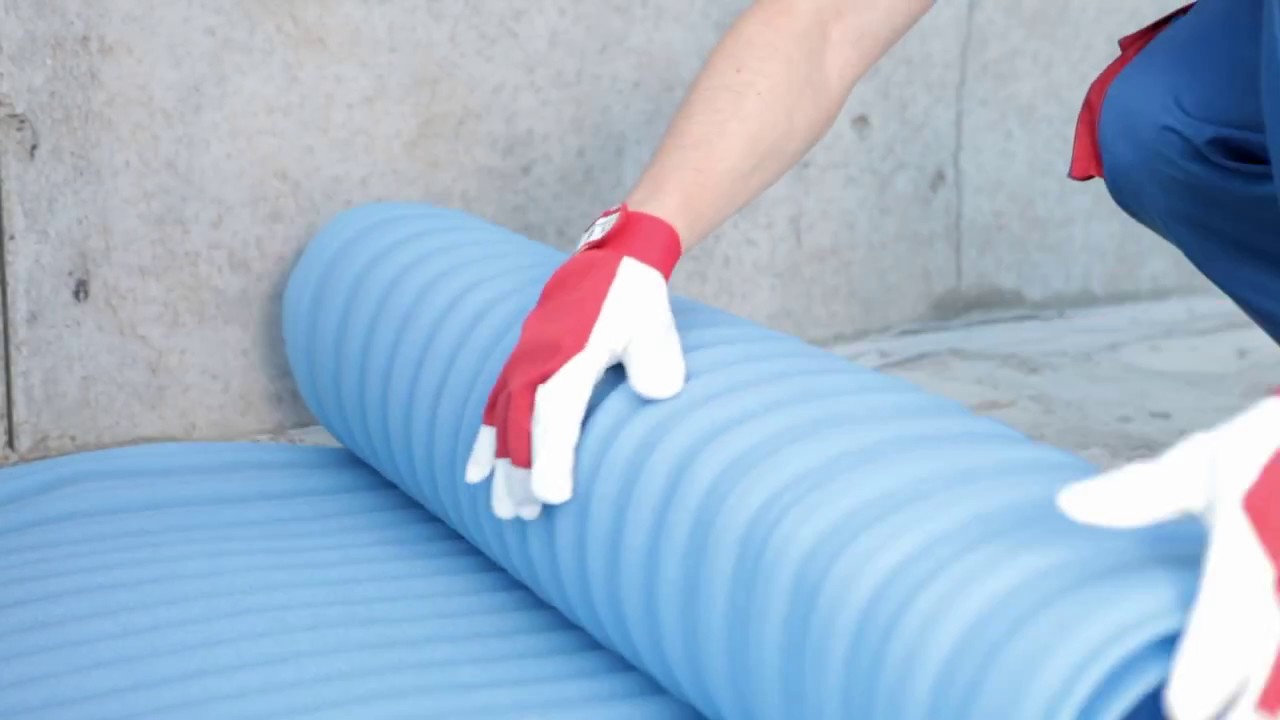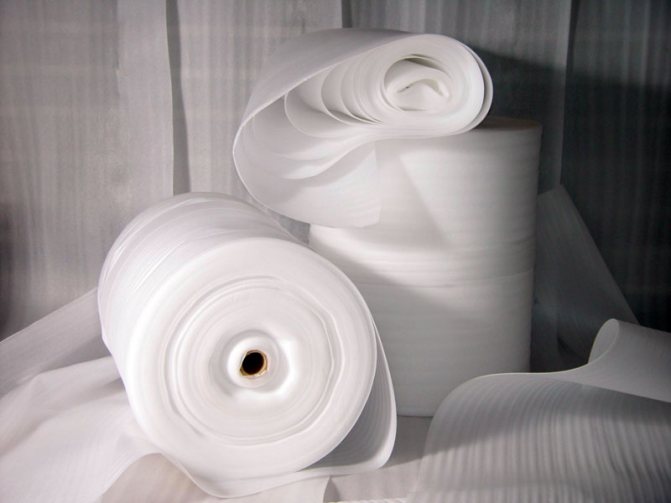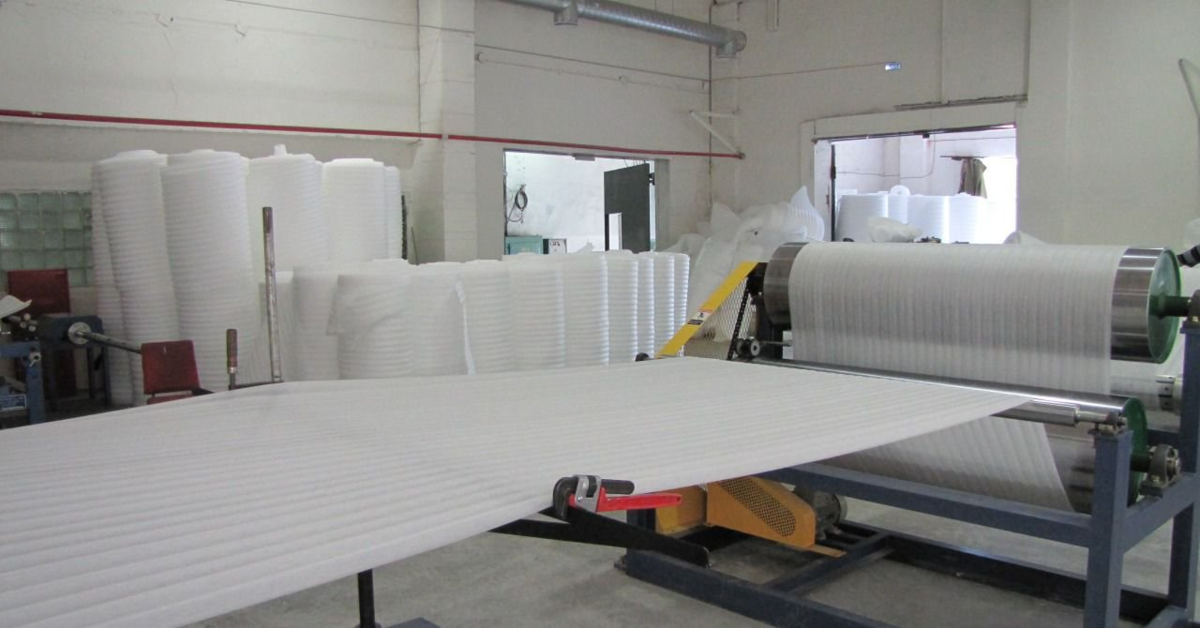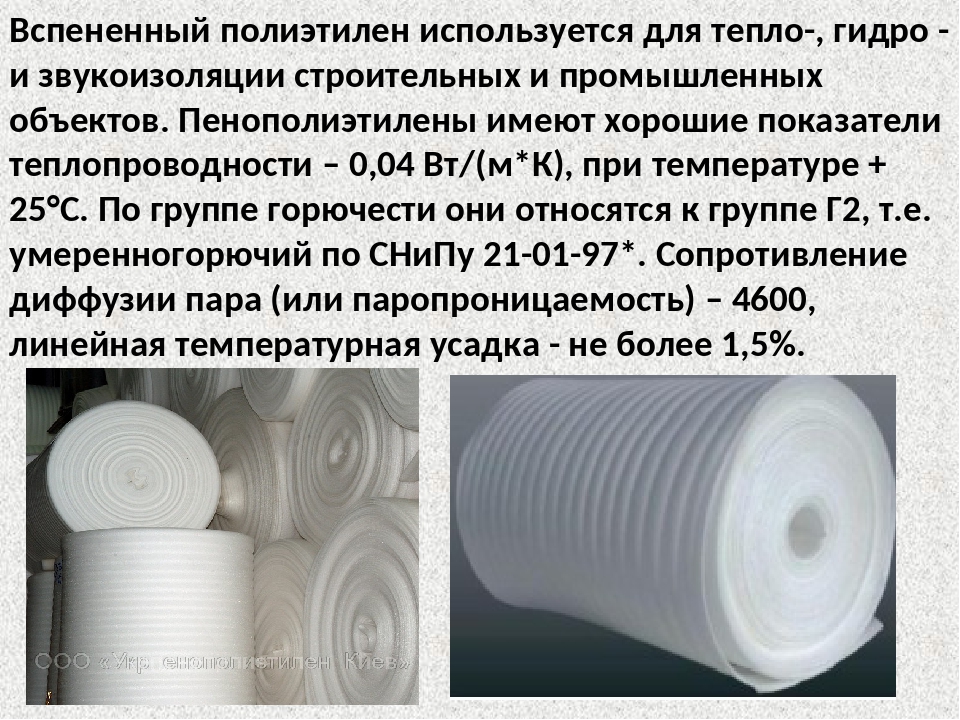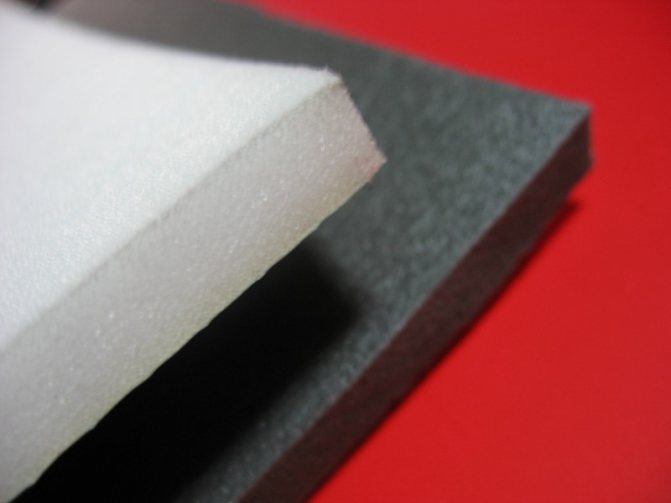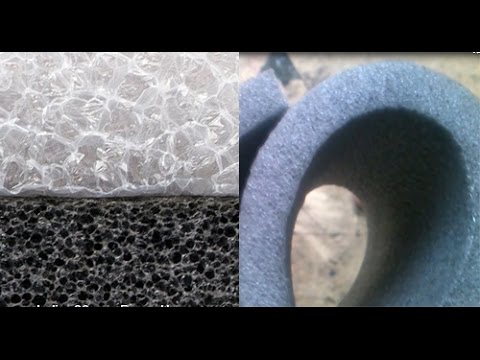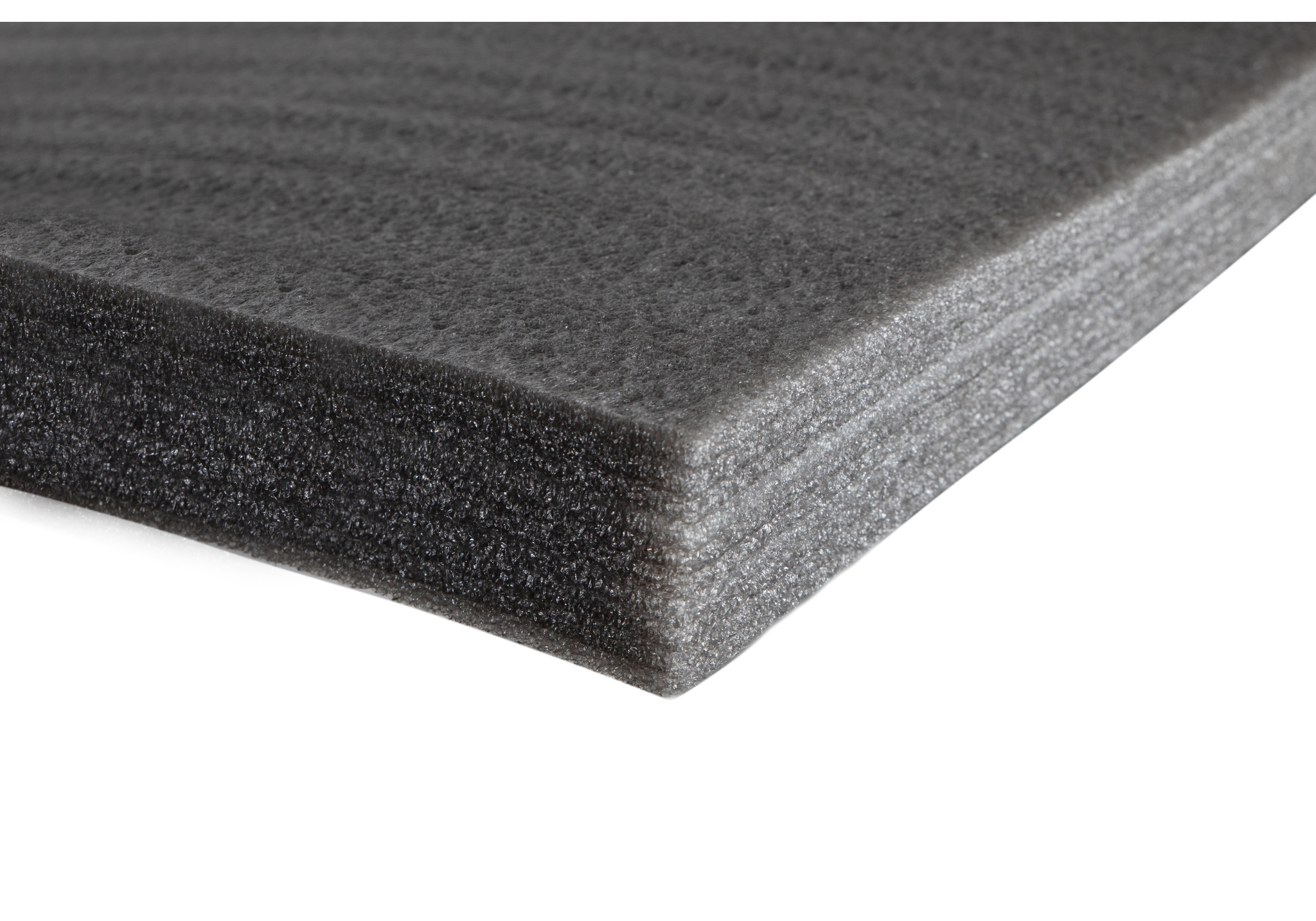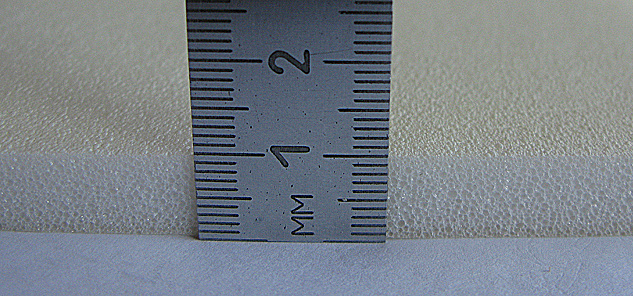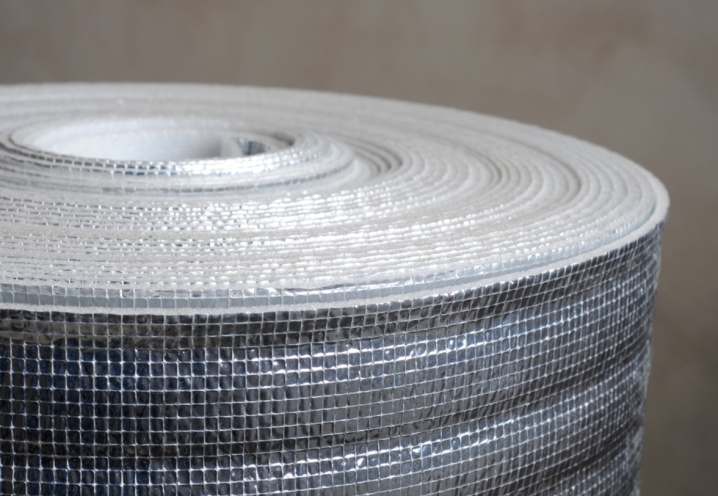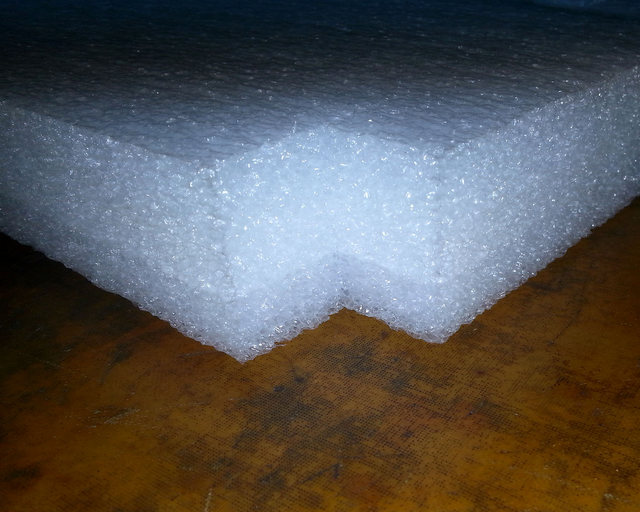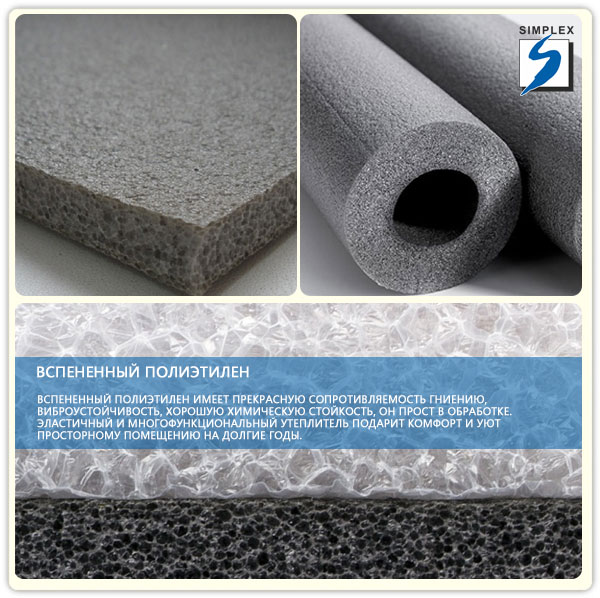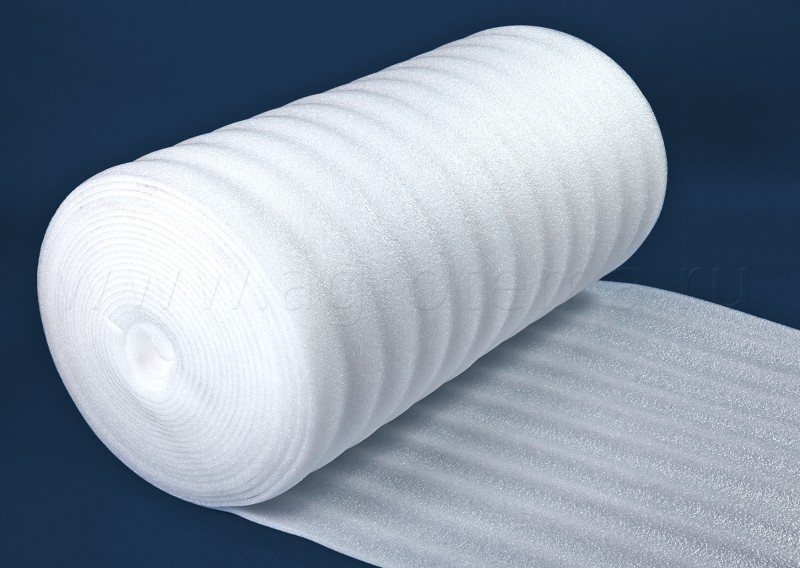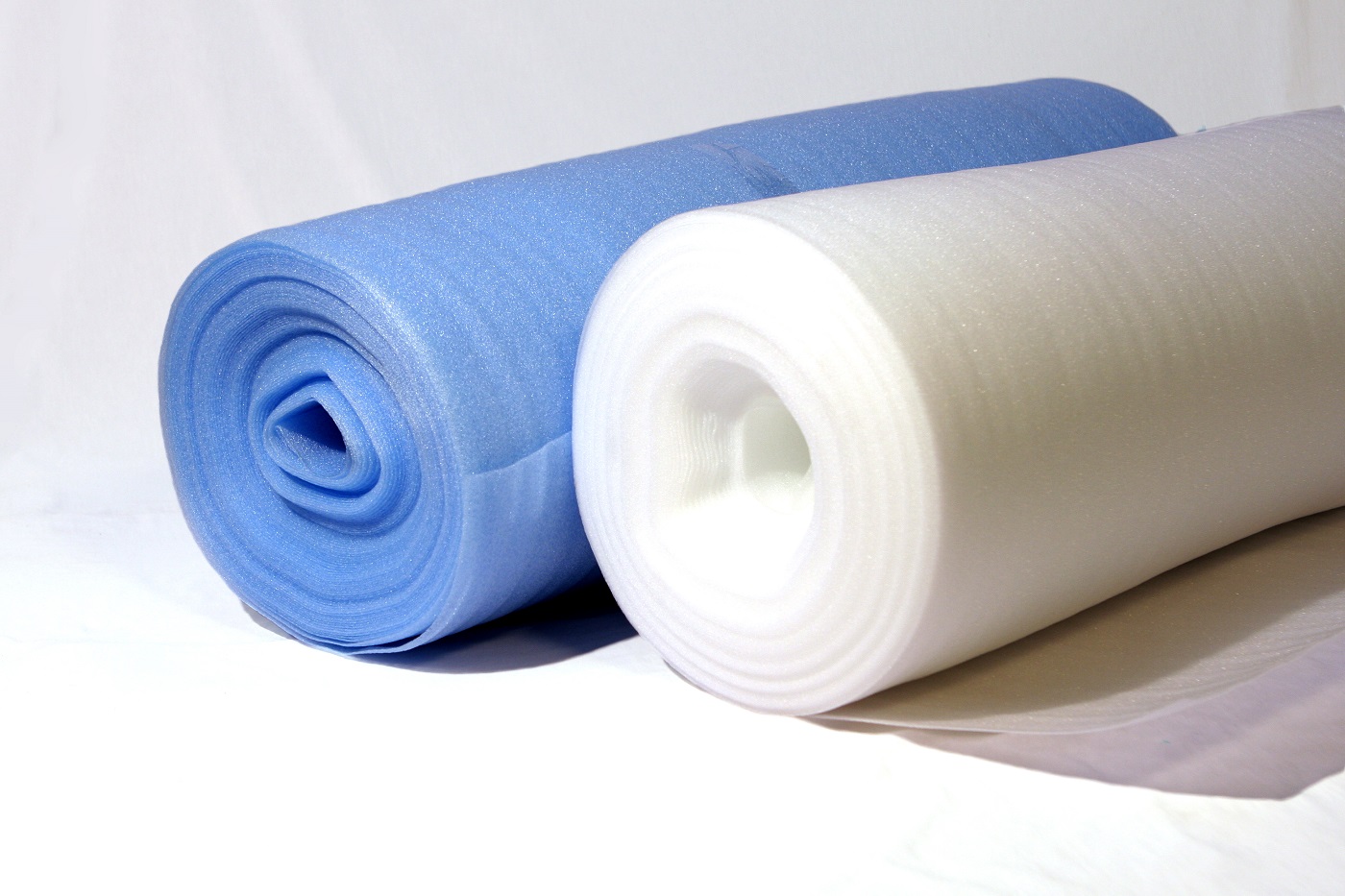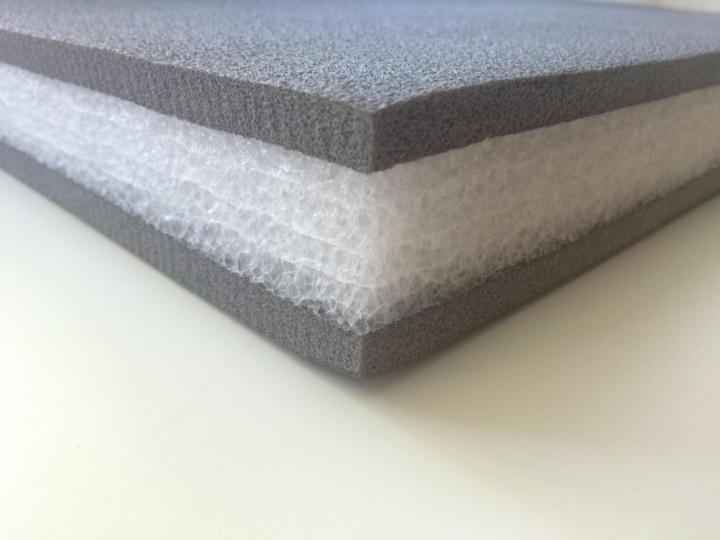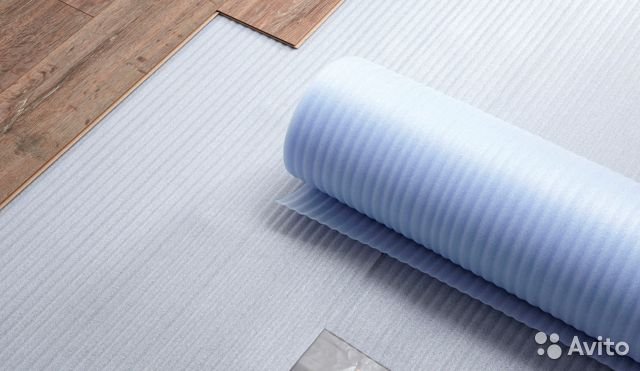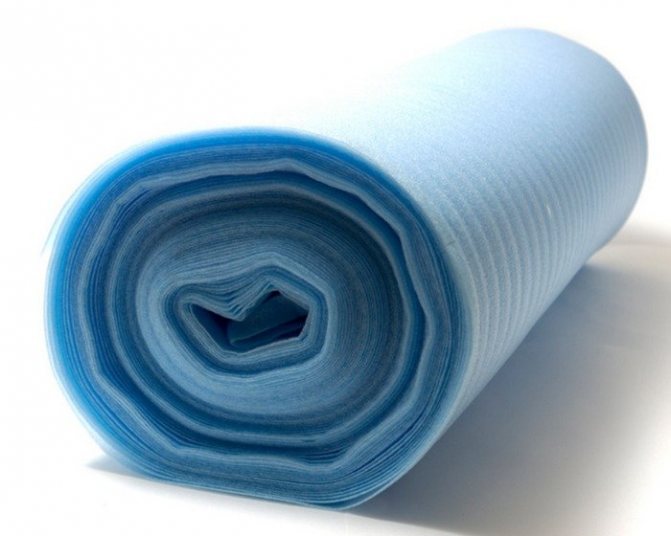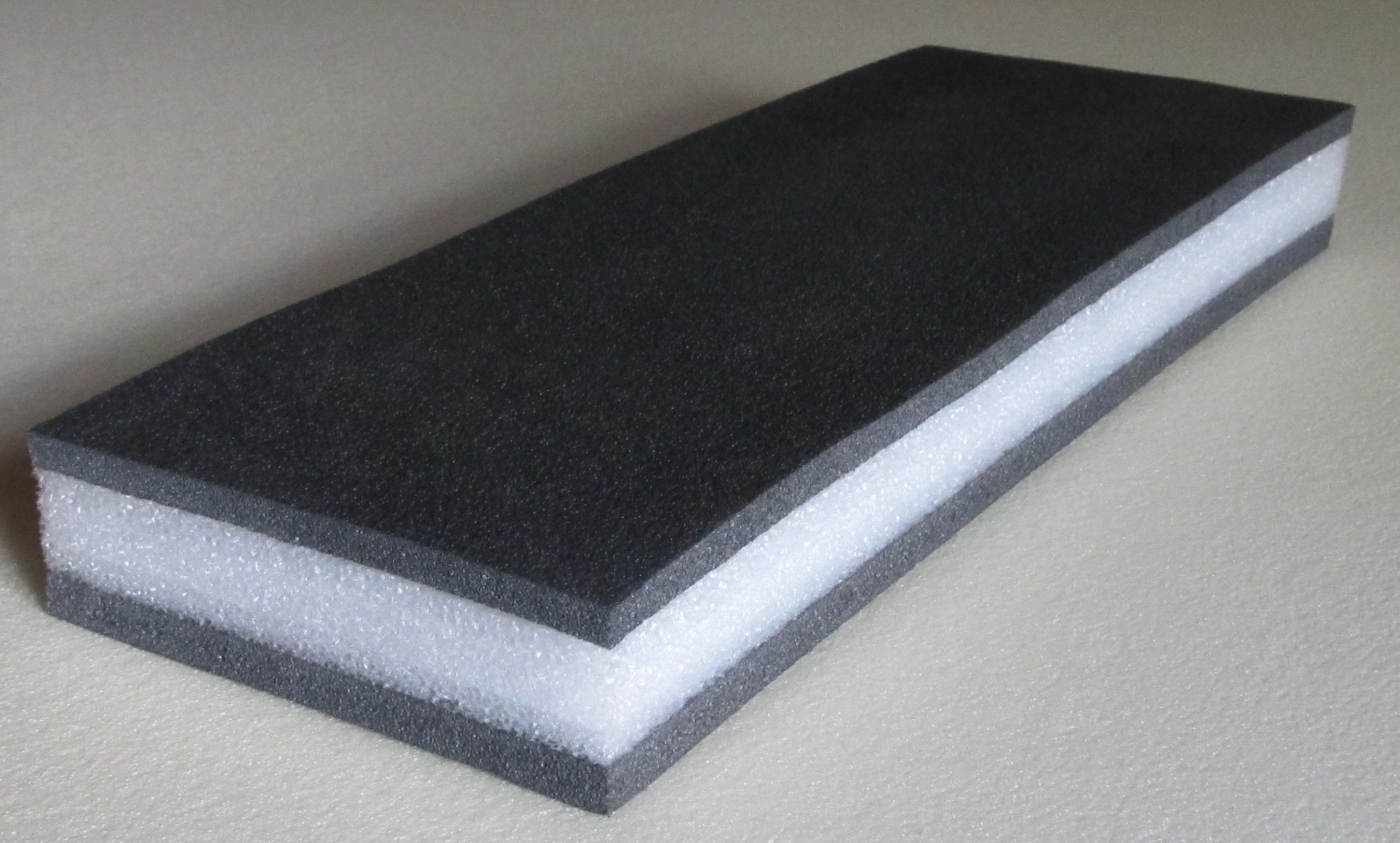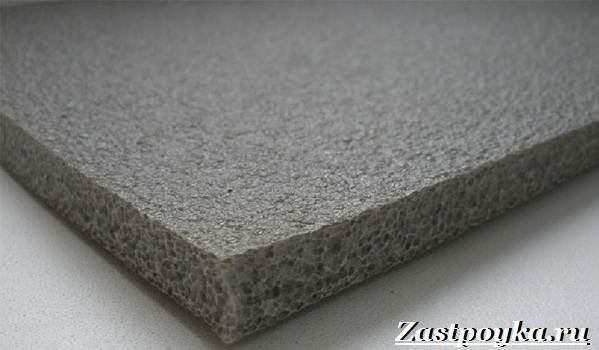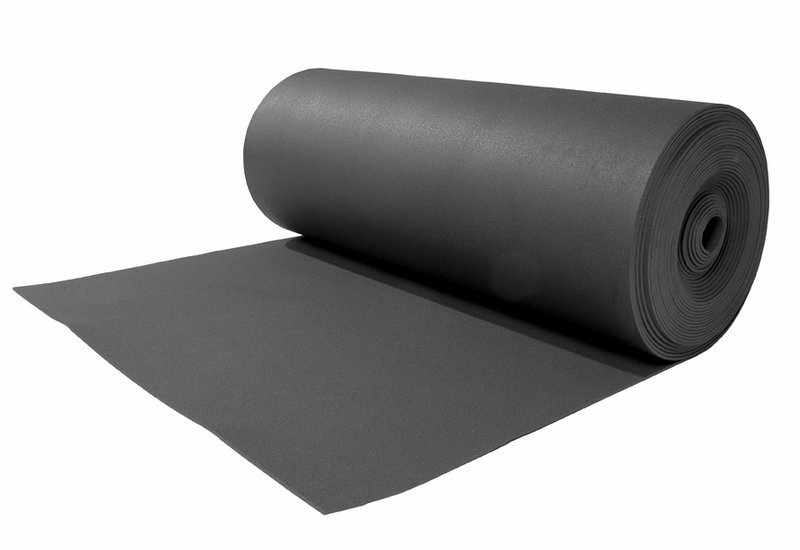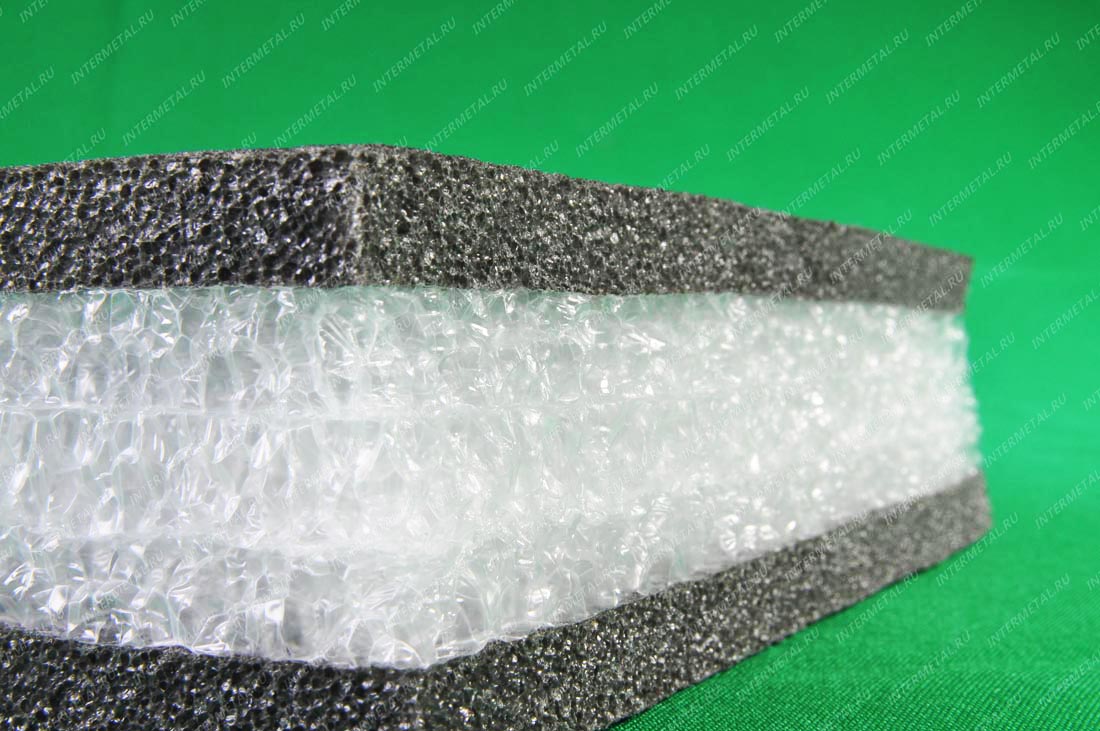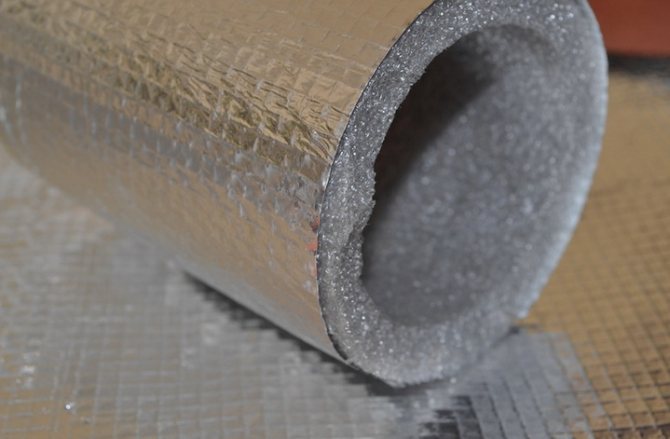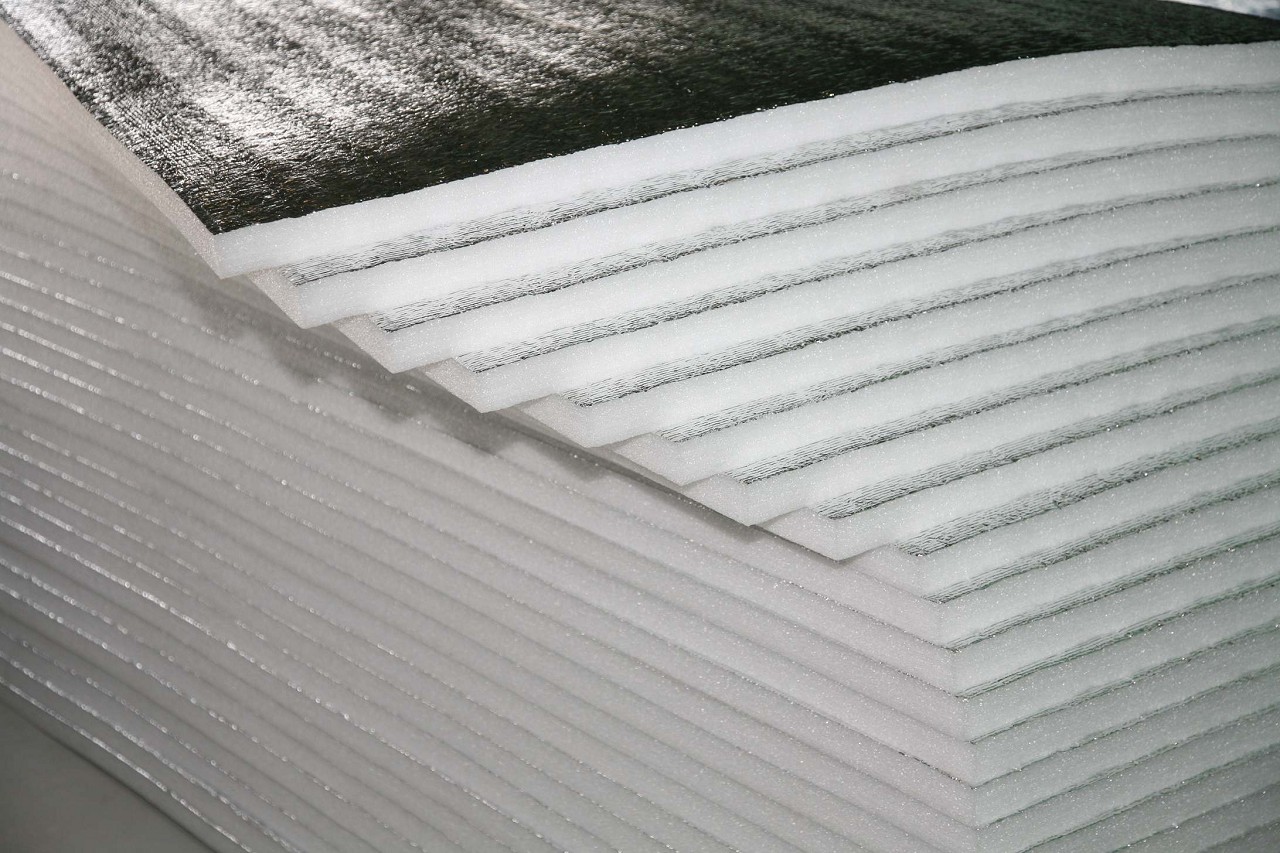Views
On the basis of foamed polyethylene, many types of insulation are produced with various purposes: heat, hydro, sound insulating slope. There are several options that are most widespread.
- Polyethylene foam with foil on one or both sides. This type is a variant of reflective insulation, most often implemented in rolls with a sheet thickness of 2-10 mm, the cost of 1 sq. m - from 23 rubles.
- Double foam mats. Refers to the materials of the main thermal insulation, used to cover flat surfaces, such as walls, floors or ceilings. The layers are interconnected by thermal bonding and are completely sealed. They are sold in the form of rolls and plates with a thickness of 1.5–4 cm. The cost of 1 sq. M. m - from 80 rubles.
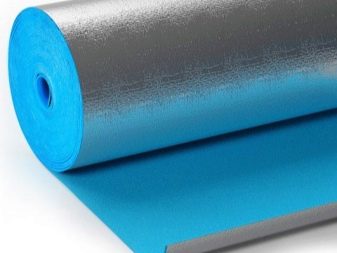
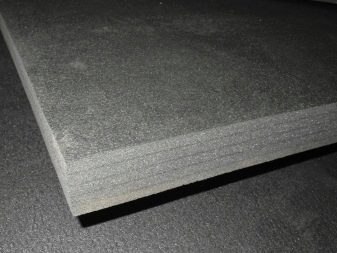
- Penofol is a branded product from a well-known manufacturer of building materials of the same name. Polyethylene foam of this type has good noise and heat insulation. Consists of a perforated polyethylene foam sheet with a self-adhesive layer for easy installation. It is sold in rolls 3–10 mm thick with a length of 15–30 cm and a standard width of 60 cm. The cost of 1 roll is from 1,500 rubles.
- "Vilatherm" is a heat-insulating sealing band. It is used for thermal insulation of door and window openings, ventilation and chimney systems. The working temperature of the product fluctuates in the range of -60 ... +80 degrees C. It is realized in hanks with a bundle section of 6 mm. The cost for 1 running meter is from 3 rubles.

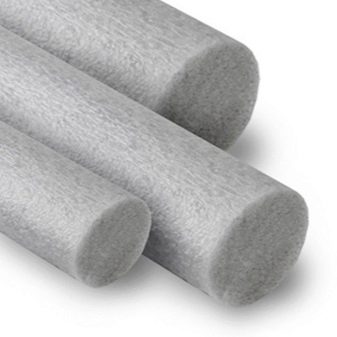
Basic properties
The technical characteristics of foamed PE are a synthesis of the properties of polyethylenes, soft elastic materials with a low melting point, and foams with their light weight and low thermal conductivity:
- Like ordinary polyethylene, foamed PE is a combustible material, the maximum operating temperature of which should not exceed + 102 ° C. At higher rates, it will melt.
- At low temperatures, even when lowered to -60 ° C, polyethylene foam will retain all its properties, including strength and elasticity.
- The thermal conductivity of this product is very low, it is 0.038-0.039 W / m * K, which gives products from it a particularly high coefficient of thermal insulation.
- In direct contact with water, foamed PE absorbs it no more than 1-3.5% of its volume per month.
- Foamed polyethylene is very resistant to chemically active media, in particular to oil and petrol products.
- Does not break down in a biologically active environment (does not rot, does not lend itself to the action of bacteria and fungi).
- Perfectly absorbs sounds, so that PPE can be used for noise isolation.
- Absolutely non-toxic, even while burning.
- Easy to transport and install,
- Wear-resistant and durable up to 80 - 100 years of service.
disadvantages
A negative property of foamed PE is its intolerance to ultraviolet rays. Direct exposure to sunlight has a destructive effect on it, therefore, both storage and use of polyethylene foam should take place in a place protected from light. Otherwise, the material itself must contain protection, at least in the form of an opaque film.
Features of polyethylene foam
- Low thermal conductivity. This allows it to be used for arranging thermal insulation layers of buildings and structures.
- Variety of assortment. Polyethylene foam can be "simple", foil, reinforced (for example, fiberglass, used for greenhouses), be part of other materials. With the introduction of various components into the initial composition, it is possible to give the final product the required characteristics (strength, frost resistance, and a number of others).
- From the point of view of ecology, the material is clean, since the use of freon is not provided for by the manufacturing technology.
- Good water repellency. Foamed polyethylene is well suited for protecting surfaces exposed to constant exposure to liquids.
- Ease of working with the material.
- High soundproofing qualities.
- Polyethylene foam can reduce the likelihood of other materials igniting. For example, it is often used to protect wood.
- Some types of products can be operated in the temperature range = 240 ° C (from - 60 to + 180).
- Possibility of lamination with almost any material (films, lavsan, paper and others). Thanks to this, it is used everywhere.
- Durability, elasticity, wear resistance. Not damaged by insects, rodents, mold or mildew.
- Low price of products, which makes them affordable for families with any income.
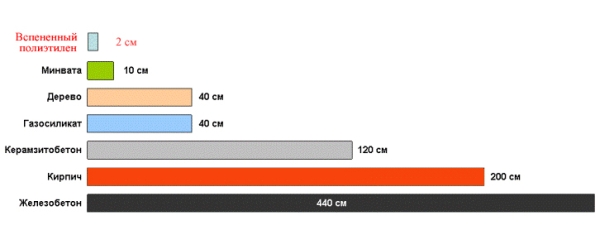 comparison of thermal insulation properties
comparison of thermal insulation properties
Application
For packaging goods for various purposes, as an interlayer
This is especially important to ensure the safety of the transportation of goods. The material is produced with a thickness of 0.5 mm to 2 cm, which allows it to be used universally.
As shields to reflect heat
This property is used, for example, when decorating saunas (steam rooms), refrigerating chambers.
At defense enterprises. This seemingly fragile material is, for example, a "component" of body armor.
Well, the most common use is to reduce heat loss by various structures (thermal insulation): buildings and structures, pipelines and utility wells, tanks and caissons, ventilation ducts and technological shafts.
By the way, products with one-sided foil are perfect for mounting on the wall behind heating radiators, as this increases heat transfer to the room (the efficiency of the devices increases by 1/3). But foiling on both sides is an excellent option for roof insulation. They reflect both the heat rising from the inside of the building and the thermal energy of the sun's rays.
Given the diverse range of products, it is impossible to list all types of products. But it is appropriate to give approximate prices for some of its varieties.
Sold in rolls. The thickness of the material ranges from 2 to 10 mm.
Price - from 23 rubles / m2.

Duplicated mats
Thickness from 1.5 to 4 cm. Convenient for thermal insulation of flat surfaces in large areas. They are connected thermally, which allows not to engage in further sealing of the seam.
Price - from 76 rubles / m2.
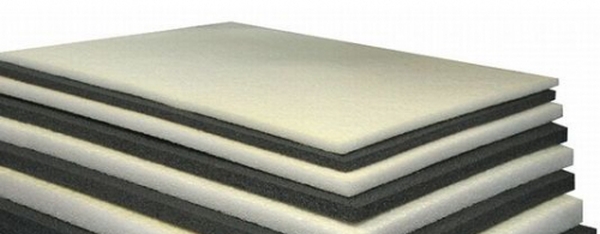
Penofol
For arranging layers of heat and vapor insulation. In rolls, perforated. Self-adhesive coating available. Material thickness from 3 to 10 mm, roll length - from 15 to 30 m with a standard width of 60 cm.
Price - from 1,200 to 1,500 rubles / roll.

Vilatherm
Heat-insulating sealing strand with a cross section of 6 mm. It is used in the temperature range from - 60 to + 80 0С. For sound and heat insulation of ventilation ducts, window and door openings (for example, in Swedish insulation technology), smoke removal systems and much more.
Price - from 3.12 rubles / r.m.
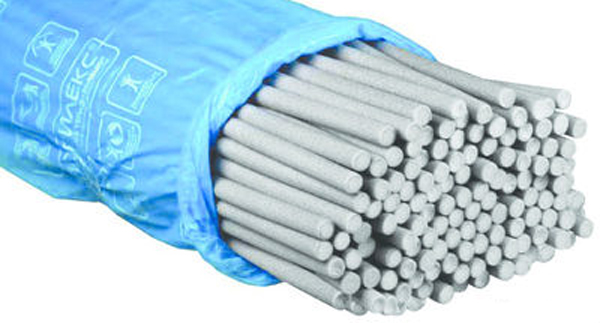
Foamed polyethylene types
Today, several types of this material are produced, which allows you to choose the best option for each specific case.
So, in the production of this heat and sound insulator, high or low pressure polyethylene can be used. The finished material may have a slightly different structure:
- foamy;
- cellular;
- pore-like.
Depending on the scope of use, the material can be produced in different forms:
- foamed polyethylene sheet is indispensable for warming and soundproofing walls, ceilings, roofs, foundations;
- tiled;
- tubes have found application when it is necessary to perform heat and sound insulation of ventilation ducts, door or window openings, etc.;
- films are great for greenhouses;
- coated. So, the material can be foil on one side, and then it is excellent for insulating walls located behind a heating radiator in order to reflect all the radiated energy.If the foil coating is double-sided, then the material is well used for insulating the roof, because in this case the rays of the sun and heat from the heating elements will be reflected, and the optimal microclimate in the room will be easy to maintain both in winter and in summer.
But most often, foamed polyethylene, depending on the molecular structure, is divided into non-cross-linked and cross-linked.
Uncrosslinked polyethylene completely retains the structure of molecules and molecular bonds of polyethylene. It is made of polyethylene by the extrusion method with the addition of a blowing agent, which foams the original product. Previously, freons were used as a gas generator, which, due to the high heat of vaporization, were ideally suited for this process. Now, after the ban on the use of freons that deplete the ozone layer, a propane-butane mixture or isobutane is used instead. All transformations take place in the extruder, after leaving which, with a sharp drop in pressure, the gas begins to expand, forming bubbles. And since the temperature outside the extruder is much lower, the finished mass quickly solidifies. The final product of the production is a translucent material with many large pores. Its strength is inferior to cross-linked polyethylene, since here the intermolecular bonds are much weaker. This dictates the field of application of uncrosslinked polyethylene foam.
This type of polyethylene foam is widely used as a heat and sound insulator in residential and industrial construction, as well as an insulator against water and condensation, but only in those rooms where it will not be exposed to heavy loads and high temperatures. In European countries, this material is used as packaging for a wide variety of items, even fragile ones, as it absorbs shock loads. In the food industry, it has found application due to its complete hygiene and inertness.
Cross-linked polyethylene is produced by chemical or radiation methods. The chemical method involves melting polyethylene under high pressure along with the initiators of the reaction and antioxidants. Peroxides, which often act as the initiator of the reaction, undergo a number of transformations, while forming bonds between individual polyethylene molecules. A similar effect can be obtained when polyethylene is exposed to a beam of energy, which is the radiation method of obtaining the material. As a result, foamed polyethylene receives a fine-grained structure, which determines its greater resistance to stress, chemicals, moisture and temperature.
Cross-linked polyethylene is a more versatile material, a reliable heat and sound insulator that can be used in a wide temperature range, which determines its distribution. It is great for insulating walls, ceilings, ceilings, floors, pipelines, it is often used simply as a sound insulator or for waterproofing foundations, cellars and basements. In addition, this material has become widespread in mechanical engineering, automobile manufacturing, and medicine. To insulate an apartment, it is better to choose sewn polyethylene foam in order to get a more durable, strong and reliable coating that will certainly cope with any stress.
Description and properties
This material is subdivided directly by its structure into two main, main varieties:
- NPE or simply - unstitched;
- X (F) PPE, simply stitched.
An uncrosslinked type of material is a material produced using an extruder from solid polymer products and butane and propane gases. This type is a linear chain of molecules without the presence of intermediate bonds, so it easily crumples, crumples and does not straighten after the cessation of mechanical action.
The sewn type of material, in turn, is divided into two large types:
- with physical "firmware", denoted by the abbreviation FPPE;
- with chemical "firmware", sometimes designated by the abbreviation HPPE.
The main difference of this type from the first from the point of view of any chemist-technologist is that the molecules have not only a linear, but also a cross-link, that is, they are "stitched" together.
The difference between physical and chemical methods of "cross-linking" is that in the first case, the establishment of cross-linking occurs due to the action of electrons, and in the second - chemical reagents, namely, free radicals.
The sewn material has noticeable external differences - it has smaller bubbles, that is, cells, it is much denser and holds its shape much better.
The stitched and non-stitched types of material also differ in their properties - the stitched type is characterized by low thermal conductivity, it is vapor-proof, easily compressed and returns to its original shape, and also perfectly absorbs sound, such as music, or any noise. Uncrosslinked, respectively, has lower performance, but also has a number of unique advantages.
The properties common to both types of material that characterize them include:
- absolute water resistance;
- resistance to the activity of any microorganisms;
- resistance to alkaline and other chemical attack;
- lack of any interaction with the environment;
- ease of installation in any field of application of the material.
A stitched type of material is more expensive than a non-stitched one, therefore, when planning to use it, you should think about whether polyethylene with "stitching" is really necessary or a more economical, not "stitched" option will suffice.
Both types of material are covered with foil, on sale this type is called "foamed polyethylene foil". Aluminum foil is welded to polyethylene using a thermal welding procedure, and its surface, outer layer is polished.
The use of foil not only increases such an indicator as the thickness of foamed polyethylene, but also significantly enhances its characteristic properties:
- thermal insulation increases up to 97% compared to the baseline;
- vapor barrier also increases significantly, due to the elimination of condensate formation;
- there is practically no effect on the sound insulation, although the descriptive instructions allow for the effect of "reflection" of the sound.
The main advantage of combining material with foil is to increase thermal insulation, for example, just a 10 mm layer of insulation made of foamed polyethylene retains the same amount of heat as a brick (red brick) masonry 15-20 cm thick.
Foamed polyethylene thermoflex with foil is produced in the following forms:
- one-sided, this type of material is glued to the subject of insulation or wrapped around, with a layer of foil outward;
- double-sided, ideal for interiors and partitions, insulation made of foamed polyethylene on both sides "wrapped" in foil, equally performs its functions, regardless of changes in the direction of heat fluxes, sound waves or noise;
- one-sided with an adhesive base, this is an "improved" one-sided type, the only difference is that you do not need to purchase glue for it;
- one-sided with film lamination, the same one-sided, but the foil layer is reinforced with a film sheet that reliably protects it from mechanical damage;
- with forced perforation is an attempt to combine the qualities of a complete insulator and a "breathing" material, reviews about it are extremely controversial, but it is this type of polyethylene foam that is best suited for heating and plumbing pipes.
Also, it should be mentioned that the installation of this material is the simplest of all installation work on insulation and insulation of premises, the material weighs very little, and one pair of hands is enough for pasting with foamed polyethylene sheet of the room.
Production and features of polyethylene foam
Polyethylene foam is made by processing high-pressure polyethylene (LDPE), to which dyes, refractory reagents and other hydrocarbon compounds are added. For manufacturing, the extrusion method is used, as a result of which foamed polyethylene with a large number of closed pores with air inside is obtained. After that, the material is subjected to heat treatment and foaming at a temperature of 180 °, and, if necessary, further crosslinking of the finished material is carried out.
Crosslinked polyethylene foam is produced by radiation or chemical means. Polyethylene, reaction catalysts and antioxidants are melted, brought to a thermoplastic state, and then sheets are formed that are stitched together. Uncrosslinked polyethylene foam is formed by foaming conventional polyethylene with a propane-butane mixture or freons.
Material features
Among the main features of polyethylene foam, it is necessary to highlight the following:
- Excellent thermal conductivity, allowing the use of polyethylene foam for thermal insulation. Indicators of thermal conductivity of foamed polyethylene - 0.037 W / m * K
- Reduced hygroscopicity. This property allows the material to be used as a protective barrier against liquids and moisture.
- High quality soundproofing. The physical properties of the material make it possible to use it as sound insulation not only in construction, but also in mechanical engineering.
- The permissible operating temperature range is 240 degrees.
- Strength and wear resistance. The material is not affected by biologically aggressive media, insects and other external factors.
Let's note an interesting fact: 1 cm thick foamed polyethylene easily replaces a 15 cm brickwork or a 5 cm layer of mineral wool.
Properties and characteristics
First of all, you need to understand what the material is. So, foamed polyethylene (polyethylene foam, PE) is a material based on traditional and well-known polyethylene. However, unlike the standard variety, the foamed type has a special closed-porous structure.
In addition, it is important to note that the foam is classified as a gas-filled thermoplastic polymer.
If we talk about the time of the appearance of the material on the market, then this happened about fifty years ago. Since then, polyethylene foam has been gaining popularity among users. Today, the production of goods complies with all international standards, which are spelled out in the corresponding GOST.
Before you decide to purchase and use the material, you must evaluate and analyze all the available distinctive characteristics of polyethylene. It should be borne in mind that these properties are not only positive, but also negative. Nevertheless, they all constitute a set of distinctive features of the material.
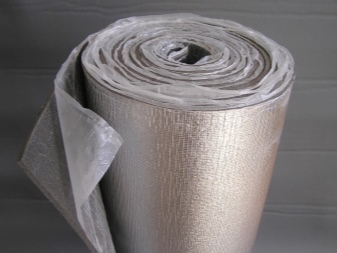
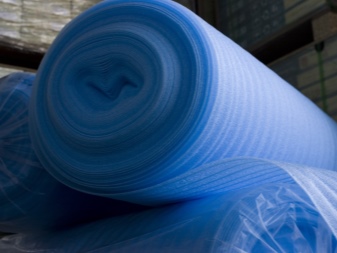
So, certain qualities can be attributed to the most important characteristics of foamed polyethylene.
First of all, it is necessary to say about the high flammability of the material. So, in the event that the air temperature reaches +103 degrees Celsius, the polyethylene will begin to melt (this indicator is the so-called "melting point"). Accordingly, during operation, you must definitely remember this quality of the material.
The material is resistant to low temperatures. So, experts report that even when the ambient temperature drops below -60 degrees Celsius, polyethylene still retains such important characteristics as strength and elasticity.
The level of thermal conductivity of polyethylene is very low and is at the level of 0.038-0.039 W / m * K. Accordingly, we can talk about a high level of thermal insulation.
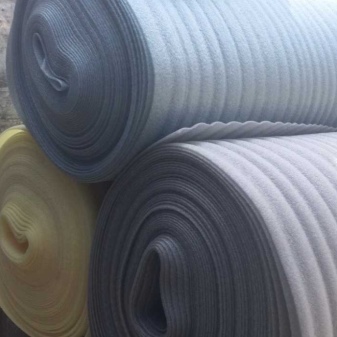
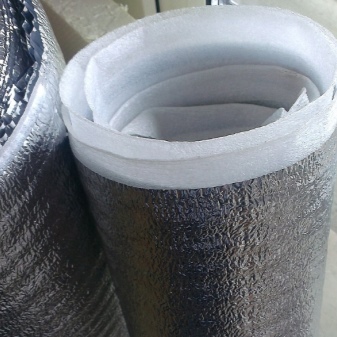
During the operation of polyethylene foam, one should take into account the fact that the material itself is capable of absorbing sound. In this regard, it is often used to equip recording studios, clubs and other premises that require mandatory sound insulation.
PE does not contain any components that can harm the human body. Accordingly, the material can be used without fear for health and life (both your own and your loved ones). In addition, even during combustion, the material does not emit toxic components.
The most important characteristic of polyethylene, thanks to which it is popular and in demand among a large number of users, is the fact that the material can be very easily transported. Also, an important role is played by the fact that the polyethylene foam can be easily mounted.
PE is a material with a high level of wear resistance. Accordingly, we can conclude that it will serve you for a long period of time. If we try to roughly estimate the service life of the material, then it is approximately 80-100 years.
During the operation of the material, it is imperative to take into account the fact that it is destroyed by exposure to ultraviolet radiation. Accordingly, direct use of the material must be in a protected environment.
Great variety in terms of color, shape and type of decoration. The most popular and demanded are rectangular sheets in black and white.
The thickness of the polyethylene can vary. This indicator plays a decisive role in the choice of material. So, depending on your needs and preferences, you can choose PE with a thickness of 10 mm, 50 mm, 1 mm or 20 mm.
In addition to the functional characteristics of PE, it is important to study in detail the chemical and physical properties of PE (for example, properties such as density, ability to absorb moisture, etc., play an important role)
Among the distinctive chemical and physical properties of the material are:
- the recommended temperature range for using the material is in the range from -80 degrees Celsius to +100 degrees Celsius (in conditions of other temperatures, the material loses its characteristics and quality);
- strength can be in the range from 0.015 MPa to 0.5 MPa;
- the density of the material is 25-200 kg / m3;
- thermal conductivity index - 0.037 W / m per degree Celsius.
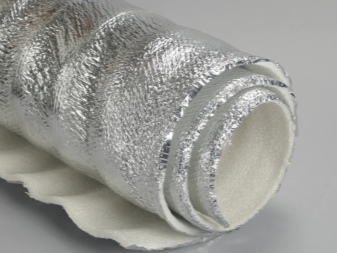
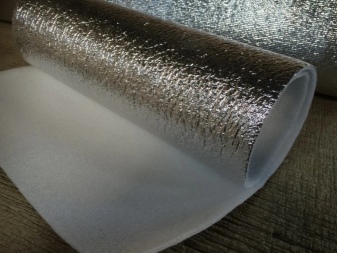
Properties of heat-insulating raw materials
Thermal pipe insulation performs a protective function for pipelines. Foamed polyethylene is used for various utilities:
- heating lines;
- cold and hot water supply pipelines;
- sewerage;
- air conditioning systems;
- air vents in ventilation.
For heating pipes and hot water supply, insulation is needed to reduce heat losses in the coolant and level the thermal expansion of the material. For cold water pipes, a heat insulator serves as protection against freezing and condensation on the surface. Polyethylene foam protects sewers from freezing and reduces noise levels. Ventilation and air conditioning pipes are protected from ice and condensation.
Polyethylene foam performs thermal insulation functions due to its technical characteristics:
- thermal conductivity coefficient is 0.03-0.04 W / m * K;
- the density of products varies with different manufacturers from 25 to 40 kg / m3;
- water absorption - no more than 2%;
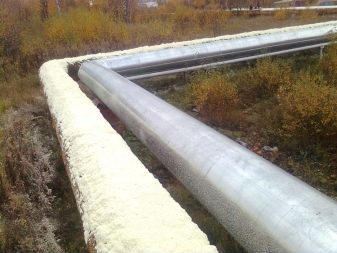
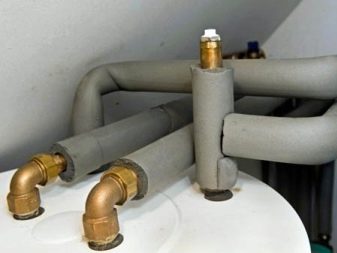
- fire resistance class G2 in accordance with GOST 30244 (refers to moderately flammable material);
- application temperature - from -60 to +90 degrees;
- vapor permeability of 0.001 mg / m * h * Pa allows the material to be classified as completely vapor-tight;
- minimum service life - 20 years, maximum - 80 years;
- strength is expressed in tensile at break up to 0.3 MPa and elastic moduli in dynamics up to 0.7 MPa;
- depending on the insulation layer, the sound absorption coefficient is from 25 to 55%;
- resistance to aggressive chemical attack.
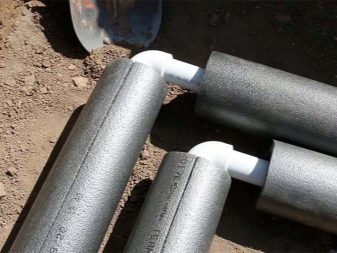
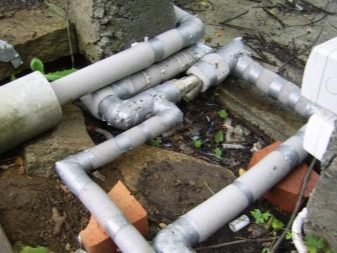
High insulating performance demonstrates the features of the insulation for pipelines for various purposes. Low thermal conductivity allows you to reduce the thickness of the heat insulator without changing the efficiency. Polyethylene foam exhibits waterproofing properties, protects metal pipes from corrosion. The material does not rot, has high hygienic properties, fungi and bacteria do not grow on the surface.
The disadvantages of a heat insulator are flammability at temperatures over 300 degrees, spontaneous combustion at 400 degrees. In addition, the material is not UV resistant.
Due to its elasticity, the material is resistant to deformation, but it can be damaged by sharp objects. Low cost and ease of installation allows the use of polyethylene foam in industrial facilities and in private engineering systems.
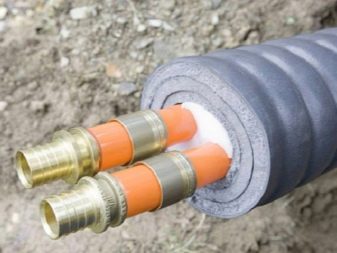
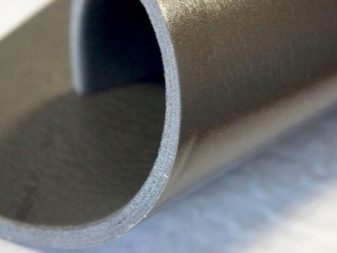
What it is?
Foamed polyethylene is an artificial elastic material consisting of gas-filled bubbles. Production takes place on special extruded lines, where polyethylene granules are mixed with reagents. In the process, the composition heats up to +140 degrees - a chemical reaction occurs, as a result of which the volume increases by 20 times and the material acquires a cellular structure.
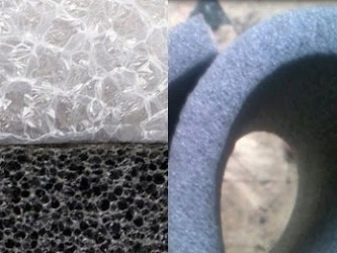
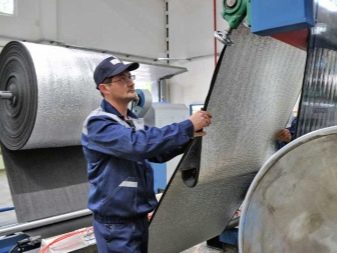
The uncooled mixture can be molded to obtain various types of thermal insulation:
- sheets rolled up for insulation of building structures and packaging;
- foil sheets with a reflective side;
- harnesses for sealing joints;
- mats for various purposes;
- hollow cylinders for pipe insulation.
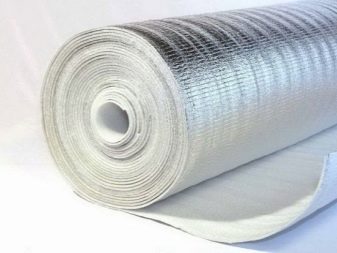

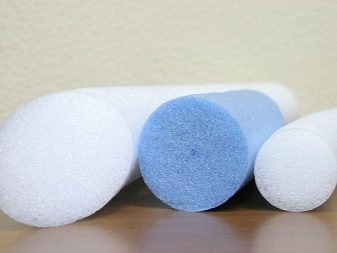
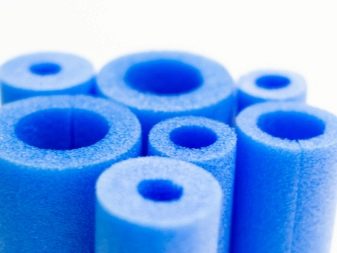
The size of the closed bubbles does not exceed 1 mm, which increases the density and technical characteristics of the material. Insulation for pipes is made from cross-linked and non-cross-linked polyethylene.
Foamed polyethylene is inert to various materials and mortars. Therefore, pipe insulation can be carried out under the ground and in open access. Polyethylene foam insulation is suitable for thermal insulation of pipes made of polypropylene, steel, cast iron, metal-plastic, polyvinyl chloride. It is used in industrial engineering systems, urban communications and private pipelines.
Application of uncrosslinked polyethylene foam
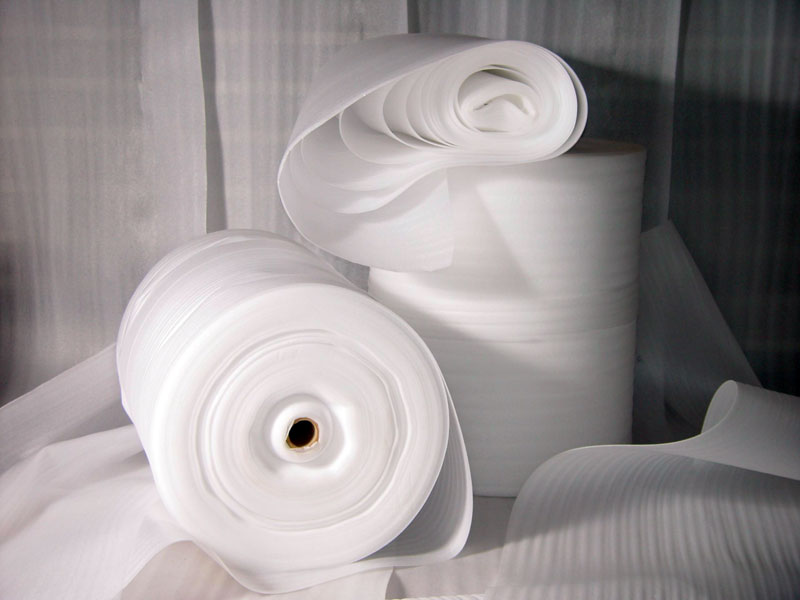
- Non-crosslinked polyethylene foam is convenient for packaging, if necessary, it softens the pressure under load. Has an unlimited shelf life. It cannot go bad, it is beneficial when packing valuable goods and cargo. In the packaging market, NPE has no equal competitors, and occupies 90% of the application.
- It is used as a packaging material for electrical equipment, dishes, furniture, glass products. Perfectly protects the surface from dust and technical debris.
- NPE is excellently used for insulation from moisture, water, steam, condensation and mechanical noise.
- With minimum quality requirements, it is used in construction as thermal insulation, mechanical engineering. Not suitable for use when there are powerful loads or too hot air temperature.
- Well used to reduce energy costs while conserving heat in the house - thanks to reflective insulation. It is widely used to level the surface, put it under parquet, laminate, linoleum.
- It has a varied form of release - in a polyethylene net, in a roll, in sheets of different thicknesses. With a laminated or foil-clad base, non-crosslinked polyethylene foam will perform protective functions depending on the requirements and the task at hand.
- In the European Union, there is a restriction on the use of IPE, it is used only for packaging.

